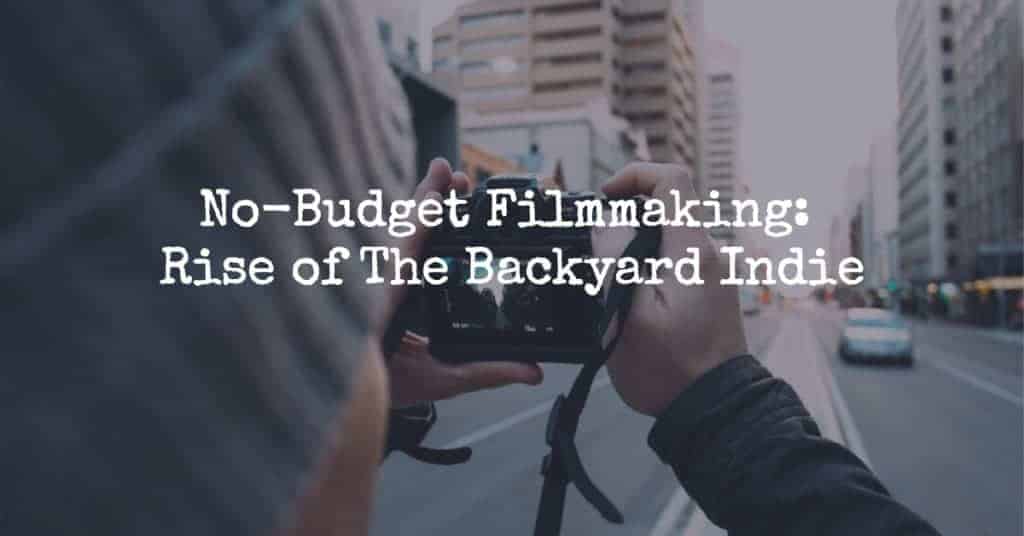Like it or lump it, there are a lot of backyard indies being made each year. Thanks to inexpensive production technology, no-budget filmmaking is not only possible, but has become the norm for many first time feature filmmakers, web series producers, YouTube creators and short filmmakers.
These days any filmmaker with passion and a story can make a film. And unlike years past, backyard indie filmmakers are not prohibited by cash or creativity. Yet despite the no-budget filmmaking movement, many of my high profile “professional” friends in Los Angeles, have made a conscious effort to ignore the rise of backyard indies. Why?
Because no-budget filmmaking isn't real! (At least, that's what some of the old school pros would tell you.) When it comes to no-budget filmmaking, a big question asked by these Hollywood hot-shots, is essentially “Who gave you permission to become a filmmaker?” Good question. Why don't you ask Roger Corman the same?
No-Budget Filmmaking: Rise of The Backyard Indie
Your audience doesn't care if the film was an official union indie or a backyard indie made for pocket change. This sentiment is further reinforced by the demise of physical DVD distribution, replaced by digital distribution. The big difference between a $10,000 backyard indie and a $2,000,000 dollar indie isn't the budget… The difference revolves around the film that gets the most eyeballs (and sales).
Think about it. Hitting breakeven on a 2M feature is going to require a lot of sales. As a rough example, to recoup 2M dollars, the filmmaker will need to to sell (roughly) 200,000 video on demand downloads at $10 a pop. These first sales will cover the 40% cost allocated to VOD providers (the real winners here), after which, the filmmaker will still need to sell an additional 200,000 downloads to repay the investors.
400,000 VOD downloads x $10 = $4,000,000 minus $2,000,000 in VOD fees = the initial $2,000,000
Meanwhile, through no-budget filmmaking, a backyard indie only has to sell 2000 VOD downloads to recover the initial 10K costs. While nobody wants to make films for pocket change, many filmmakers still believe we can somehow continually produce unprofitable (film) products and expect the money and the subsequent jobs to keep rolling in.
What's The Sweet Spot For Indie Film?
Unlike years past, accessible distribution channels allow filmmakers to take a much more pragmatic approach to creating films. Gone are the days where you approach investors with the cliche pitch: “Filmmaking is a risky investment – if we are lucky, we might win Sundance and get a deal.”
With transparent distribution options available to all filmmakers, that line of give-me-money reasoning is reckless, no longer applicable, and in my opinion, unethical. And for these reasons, no-budget filmmaking makes a lot of sense. Aside from the initial challenge of sales and marketing, the ripple effect reveals an even greater conundrum:
How will you raise enough money to pay your cast and crew AND still pay back your investors? What's the new sweet spot? How can we once again make independent filmmaking profitable?
“I CAN'T AFFORD TO PAY MY CAST AND CREW. WHAT DO I DO?”
Here is the modern moviemaking model on how to save the movie industry.
(And you thought this was going to be your typical no-budget filmmaking article.)
What About Netflix?
I would be remiss if I didn't at least mention Netflix. So I'll be quick. Netflix should be regarded as a premium subscription channel like HBO or Showtime. Since getting a deal requires that you work with a sales agent, distributor or aggregator (with a relationship), this is not something you can control. For this reason, Netflix is a lottery. And even if you do win, a lot of deals fall into the 40K-60K for a two year license… So getting a deal cannot be your only means of survival.
To survive in this ever changing world of indie filmmaking, we have to change our strategy. Instead of focusing on making that one big awesome indie that WINS THE LOTTERY, we need to focus on building a genre specific movie library and spend all of our downtime building a ginormously targeted customer list.
- Step 1: Find your top-ten closest filmmaking collaborators. Form a company.
- Step 2: Write a business plan, but instead of putting all of your focus on making one movie, concentrate on making 3-5 feature films.
- Step 3: Make sure that you include a sales and marketing plan for each film. To do this, take your proposed budget for all movies and work backwards. Start asking yourself, “How many units do we need to sell to recoup our investment? How will we do this?”
- Step 4: In this model, instead of paying freelance day rates, you'll have to hire long term employees and provide each with a salary and back end points (sort of like stock options) on each title.
- Step 5: When the title wins, you all win. Over the years, your titles will add up. And the real compensation will come back in the form of residual income.
Filmmakers Must Change Strategy
While this is not a fully refined model, it's a start. Creating a sustainable business model is better than ignoring no-budget filmmaking and pretending backyard indies are not real movies. We are experiencing a time of change.
This is the indie movie distribution equivalent of the automobile replacing the horse drawn wagon.
You can choose to ignore this movement, and you can probably succeed for a few more years. But there will come a day when all entertainment will be on-demand and cheap to produce and cheap to consume. The question is, will you ignore the no-budget filmmaking movement and continue to play your distribution lottery ticket in hopes of winning the dream deal? Or will you join the movement and help us filmmakers figure out a way to make indie movies profitable?


